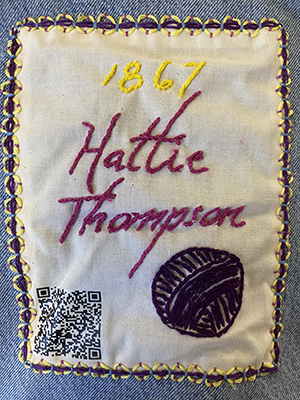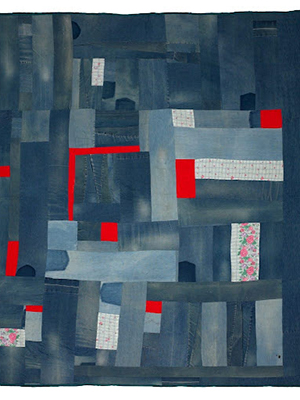Hattie Thompson
“I was born the second year after the surrender. I was born close to Arlington, Tennessee. My parents was Mariah Thermon and Johnson Mayo. They belong to different owners. Mama was hired. She was the house woman and cook for her young mistress, Miss Sallie Thermon. I heard her say she raised Miss Sallie’s children with her own. She was a wet nurse. She would spin and weave and the larger children did too. They made bedspreads in colors and solid white. They called the colored ones coverlets. Mama helped quilt. She was a good hand at that. They made awful close stitches and back stitched every now and then to make it hold. They would wax the thread to keep it from rolling up and tangling.” – Hattie Thompson
 Giftbelle Lomotey ’25
Giftbelle Lomotey ’25
Like many enslaved people, Dinah Miller was kidnapped from Africa, sold for a dime, and carted to Alabama to work on a plantation. What she actually did was to inspire generations of people with the art of quilting. Instead of copying traditional Dutch or English patterns, The enslaved women of Gee’s Bend, Alabama pieced together abstract multicolored strips into designs that resemble Ghanaian kente cloth. Using old grain sacks, discarded clothing, and whatever scraps they had saved, these talented women created a new art form that attracted attention from around the world. In 1965 Dr. Martin Luther King Jr. told them that their quilts renewed his strength to keep marching. A white Episcopal priest had the idea that selling the quilts at an auction in New York City could raise money for Southern women in the civil rights movement. Modern artists were stunned by their bold beauty. Fashion editor Diana Vreeland showcased them in Vogue magazine, and The New York Times called the quilts ``Some of the most miraculous works of modern art America has produced.” When artist Amy Sherald painted her portrait of Michelle Obama for the Smithionian’s National Portrait Gallery, she chose Gee’s Bend quilts as the inspiration for her magnificent dress, which dominates the composition.
Sources
- Federal Writers' Project: Slave Narrative Project, Vol. 2, Arkansas, Part 6, Quinn-Tuttle. 1936.
- Quilts That Embody the Legacy of Black America, nga.gov
- Art Review; Jazzy Geometry, Cool Quilters - The New York Times
